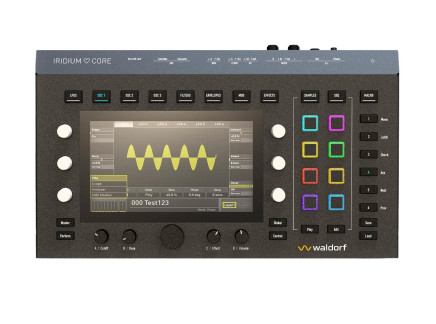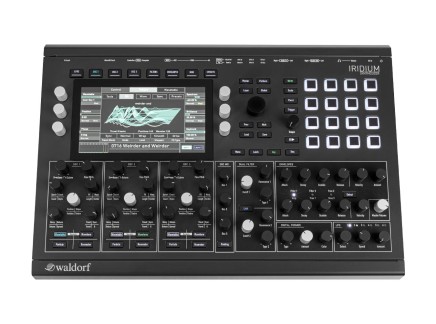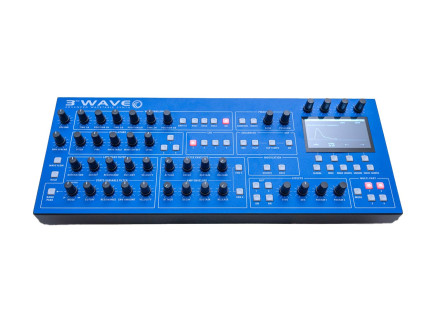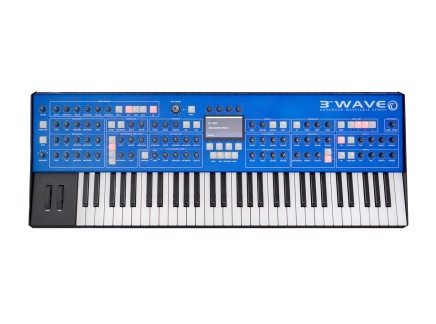Wavetables have a lot to answer for. They demonstrated that we don't have to put up with the inconsistency of wavering analog waveforms; instead, we can embrace the deliciously glassy smoothness of digital mathematical perfection. And let's not stick to a single shape—let's put a whole load of shapes into a load of tables and then struggle to decide which table to use.
But then, why struggle when you can just sweep through them all for wonderfully tantalising timbres? Wavetables give us incredible sonic flexibility from painfully simple building blocks. They can sound very distinctive, but you wouldn't always realise this, because many things labelled as Wavetable sound sets are not, in fact, wavetables. But let's see if we can get to the bottom of it all.
PPG & the Early History of Wavetable Synthesis
Wavetable is a form of synthesis that uses a bunch of digital waveforms stored in a table, hence “Wave” and “Table”. The table in question is just an array—numbered location to allow a digital system to select a stored waveform. The chosen waveform would then cycle to generate sound, just like an analog waveform. The sine, triangle, sawtooth and pulse shapes of analog oscillators are marvellous and allow us to generate a wide variation in sound and timbre. However, they are also limited—and from their beginning, Wavetables offered the promise of almost limitless shapes and tonal possibilities. At the very least, they sound a bit different and gave musicians new colors to work with. (Ed.: for a more thorough account of how Wavetable synthesis works, be sure to check out our article What is Wavetable Synthesis?—but for now, let's dive more deeply into their history.)
The core concept was first used by computer music pioneer Max Mathews at Bell Labs in 1958. It feels ridiculous to think that there were computers in 1958, let alone people making music on them—but regardless, Mathews generated sixteen wave shapes for a digital oscillator through his MUSIC II software, written on an IBM 7094. While Wavetables did pop up in experimental music from time to time, It wasn't until the release of the PPG (Palm Products GmbH) Wave 2 synthesizer in 1981 that anyone really started to take notice.
[Above: a PPG Wave 2.3; image from Perfect Circuit's archives.]
The PPG Wave 2, in its striking blue livery, was designed by Wolfgang Palm. It sounded like nothing else out there. Its predecessor was the Wavecomputer 360, which was a wavetable technology breakthrough—but according to some, it suffered from sounding rather harsh and unpleasant. So, with Wave 2, Wolfgang combined the wavetables with the warmth of analog filters and VCAs, and this turned out to be the key to a much more enjoyable musical experience.
But it wasn't just the difference in shape that distinguished the sound of wavetable oscillations from analog ones; it was the ability to change between them. A wave table could store any number of waveforms, and you could step through them using a control on the synthesizer. That's why we call it "wavetable": it's all about using tables of waveforms, and dynamically selecting waveforms from that table as the sound plays out. The waveforms could be anything, and the movement from one to another gave wavetable synthesizers that distinctively digital sound.
Of course, a carefully-planned relationship between waves tends to make the journey through a wavetable a bit more continuous, smooth, and enjoyable. You could generate this by having two different waveforms, a start and an endpoint, and then ask a computer to fill the wavetable full of steps along the way from one to another. This created a now-familiar morphing effect as you moved through the steps, with each new waveform bringing a small harmonic change to the last one. In the time of the PPG Wave, this was revolutionary.
Change is always the key to synthesis. With traditional subtractive synthesizers, it's the animation of the filters that brings the harmonic movement that we find so pleasing. In additive synthesis, it's the evolving spectrum of the timbre caused by bringing in more harmonics. With wavetables, it's the movement from waveform shape to waveform shape that generates the interest, pricks up our ears, and captures our attention. In early wavetable synths, you could feel the steps between the waveforms, giving them a slightly unreal and digital feel. Later on, larger lookup tables and mathematical interpolations filled in the gaps between waveforms, giving you a much smoother, morphing feel.

[Above: a demonstration of the effects of wavetable position modulation from the Waldorf Microwave user manual.]
But, back to the PPG Wave 2. The original had 8-voice polyphony with a single digital oscillator per voice. You had 32 wavetables to choose from, and each wavetable housed 64 waveforms. The analog filter and VCA coupled with the knobs on the front panel gave the synthesizer a very friendly and familiar vibe. It bridged the gap between the weird computer-based digital processors and the analog musician. It also had an onboard sequencer that could capture automation of many things, including the all-important movement through the wavetables.
Within a year the PPG Wave 2 was upgraded to the Wave 2.2, which added a second digital oscillator per voice, massively increasing the scope of the synth. It also added rudimentary sampling capability, which, while brilliant, caused a bit of confusion between wavetables and sample-based sound synthesis that we still feel today.
There is indeed plenty of crossover between the two forms of sound generation. Wavetables can be generated by hand or mathematically within a digital system, but it's far easier just to extract waveforms from recorded sound—or samples. So, wavetables are commonly created through sampling, and that's what was added to the Wave 2.2: the ability to create your own wavetables.

[Above: image from a PPG System brochure, featuring the Wave, PRK Processor Keyboard, Waveterm, and EVU Expansion Voice Unit.]
Other machines with similar capabilities, such as the Synclavier and Fairlight, were massively more expensive—and the Wave system took a somewhat more modular approach, in that you could use the Wave 2.2 or 2.3 as a Wavetable synthesizer with or without the Waveterm and other peripheral devices. Sampling and other more complex compositional processes, though, could only be achieved with the Waveterm and other peripherals connected.
This may have been a contributing factor to what later became a general confusion about the very definition of wavetable synthesis. What we now think of as "sampling" and wavetables are very different, even if they have the same origin. Wavetables use a single waveform cycle to act as an oscillator, whereas sampling plays back a longer sampled piece of audio and changes the playback speed to alter the pitch. Another sample-based form of synthesis was S&S or Samples and Synthesis, where we get synths like the Korg M1 and Roland D50. S&S used short samples to replicate different aspects of an instrument before running them through a traditional synthesizer architecture.
There was one more disruptive event that mischaracterised wavetables a little bit later that greatly impacted what people understand as wavetable. It was June 1992, and the introduction of the Creative Labs Sound Blaster 16, or more importantly, the Wave Blaster daughterboard. It added a "Wavetable" sound set to the FM chip that was already on the card. However, it wasn't a wavetable synthesizer—it was an S&S-based sound set. The same incorrect usage was taken on by the Gravis Ultrasound card and the Microsoft GS Wavetable SW Synth that was built into Windows. What can you do?
Anyway, the PPG Wave was way ahead of its time, and quickly added MIDI, computers, hard drives and the potential of DSP-based software emulations before S&S-based synths came in thick, fast and cheap—in part responsible for PPG's untimely end in 1987. But, thankfully, it didn't end there for Wolfgang.
The Next Steps: Waldorf and Wavetable Synthesis
[Above: the Waldorf Microwave; image via Perfect Circuit's archives.]
It was another Wolfgang, Wolfgang Duren—the German distributor of PPG—who took things forward in the little town of Waldorf, just outside Bonn in what was West Germany. Their first product, the Microwave was released in 1989. The Microwave was based on wavetable synthesis running on a chip designed by Wolfgang Palm and put together by many ex-PPG employees. It reflected or evolved the PPG Wave, but in a neat and streamlined rack mount form. It had the same wavetables, the same hybrid architecture of digital oscillators, analog filter, and analog VCA…and it was both powerful and classy. But it did lack the hands-on feel of the PPG.
It took Waldorf a few years to remedy that, but in 1993 the awesomely breathtaking WAVE appeared. It was a dream of a synthesizer.
[Above: the especially elusive Waldorf Wave Midnight edition. Images via Perfect Circuit's archives.]
The WAVE was a deliberate move away from the "Data Entry" method of programming that had become so very popular (although only because it made synths cheaper), and into the top-flight, high-end of deluxe instrument building. It has 16 voices, eight parts, and it used the now familiar digital/analog hybrid architecture of what they called Dynamic Spectral Wavetable Synthesis.
The WAVE has no internal effects, no drums, and it was a sound designer's space-age fantasy. It had 64 wavetables with 128 waves and included basic analog-style waveforms, so you could use it like a traditional synth. But once you engaged the modulation and started pushing the harmonic structure, the Wave took off through the warm analog filters on a journey all of its own.
Waldorf made fewer than 200 of the WAVE, but it put them on the map as masters of all things wavetable. From there, the Microwave moved and evolved into various versions where more wavetables were added and effects integrated.

[Above: the 1998 Waldorf Microwave XT, the next generation of Wave-influenced designs at Waldorf. Image via Perfect Circuit's archives.]
With the Microwave XT in 1998, it was blessed with 44 knobs and an especially '90s aesthetic featuring some particularly loud shades of orange. Waldorf also stepped into other forms of sound generation with the Pulse analog monosynth and the Q DSP-driven virtual analog synthesizer, with a massive forest of knobs across a sea of yellow. In 2000, they released the first official PPG 2.V virtual instrument version of the Wave 2.x.
During the 2000's, Waldorf Electronics ran into some trouble, going bust at one point and then returning almost immediately as Waldorf Music. A year later, in 2007, they released Blofeld, which is probably their most successful synthesizer (still available as of the time of publishing this article). It was small, affordable, and boasted engines from both the Q and the Microwave. A slightly expanded version was housed in a four-octave semi-weighted keyboard. From there, they flirted with more VST Instruments, did some physical modelling, made some cool little synths and some very distinctive-looking Eurorack modules. But nothing, with the exception of the Blofeld, really seemed to stick and for a couple of years, things went a bit quiet.
Waldorf's Quantum Leap
And then, in 2018, boom! Quantum! This thing was huge: an epic synth with an extraordinary roster of sound generators. The Waldorf Quantum felt like returning to the roots of the WAVE while pulling every form of futuristic synthesis with it. Waldorf was back with another hybrid synthesizer, but this time wavetables were just one of many sound-sculpting options. Each of the three digital oscillators could offer any of five synthesis algorithms. You could have your wavetables, of course, but you could also have virtual analog, granular sampling, resonator sculpting, and in later updates, a strange form of synthesis called Kernel that crashed audio rate wavetable modulations into 6-operator FM. Quantum is beautifully designed; it uses a full-colour touch-screen and an innovative use of colour to repurpose knobs and draw your attention to where you should play.
The current version supports 16 voices, dual timbral split or layered, detuned waveforms, two analog filters, digital effects, an extensive modulation matrix, sequencing and polyphonic aftertouch and much more. It can store up to 10,000 sounds, comes with 2GB of sample library, 4GB of internal flash memory for wavetables and 59GB of storage. It's a ridiculously great machine.
Quantum is a premium, flagship synthesizer, and just like the WAVE, needed the Microwave for regular synth users to enjoy, so the Quantum has the "M". The Waldorf M is a cleverly-designed reimaging of the Microwave. It pulls in tones from all the Microwave versions and combines them with a superb and familiar analog filter and VCA. It is eight-voice polyphonic (with an option for 16 voices), with two oscillators per voice, four-part multitimbral, and has a stunning layout that is light years ahead of the Microwave XT. It has loads of envelopes and LFOs, a 16-pattern arpeggiator, true stereo panning and appropriate bit-reduction depending on what Microwave mode you're in.
Waldorf has also created a synth that sits between the two. Iridium was originally (I believe) conceived as a virtual analog synthesizer like the Q—but as the Quantum engine developed and matured it seems that Iridium was completely up for handling it. And so Iridium has gained all five algorithms, making it a compact Quantum but with a slightly different architecture. It benefits from 3 stereo digital filters per voice, lots of modulation, digital waveformers and performance features such as an arp and 4x4 performance pads. The Iridium keyboard version makes you wonder why you'd need the Quantum, but it's only in the Quantum that you get the fully hybrid digital oscillators through analog filters and VCA and innovative interface.
Iridium is available in three forms: the original Iridium Desktop, the polyphonic aftertouch-capable Iridium Keyboard, and the newest member of the lineup, the Iridium Core—which foregoes a built-in playing interface, under the assumption that users will pair it with their MIDI controller of choice.
Crashing Waves
Outside of Waldorf, wavetables have also found a welcome home in software instruments. Wavetables are often visualised in a 3D space with time and loudness on the XY axis, which is extended out in the Z axis to show the movement of waveforms forwards and backwards through the table. And that's the sort of thing computers do very well. Serum from Xfer is generally regarded as the best wavetable synth on the market. It's one of those "why would you need anything else" type synths. The sounds are huge, the library exhaustive, and the interface is detailed but clear enough not to overwhelm you. Pigments from Arturia have some excellent wavetable oscillators, as does Massive X from Native Instruments. Many people rave about the simple elegance of the Ableton Wavetable as well, native to the Live performance DAW.
However, wavetables in hardware have also been making a comeback. The Argon8 from Modal Electronics is a fine 8-voice wavetable synthesizer in a classy form with lots of control, modulation and morphable filters. The Hydrasynth from ASM manages to do things differently by cleverly using macro controls, custom routings, waveform mutators and a pair of filters. Naturally, there are others: Korg's Modwave, Sonicware's Liven Bass&Beats, 1010 Music's Nanobox, and plenty of other standalone synths use wavetable synthesis as a core element.
Eurorack modular also enjoys a bit of wavetable particularly because of the emphasis on modulation. The Osiris from Modbap Modular is a superb example of how a wavetable oscillator can bring such difference and timbral changes to a modular setup. There are countless others, as well: the Industrial Music Electronics Piston Honda MkIII, the Neuzeut Instruments Warp, the 4MS Spherical Wavetable Navigator—truly, wavetable synthesis has become a standard part of the modern sound designer's toolkit.
But, probably the most unashamedly PPG-inspired synthesizer available today is the 3rd Wave from Groove Synthesis.
3rd Wave is blue, which is the only clue you need to know what this is about. The knobs and buttons are also reminiscent of that classic Wave 2. So, too is the hybrid nature of the signal flow: like its forebear, it uses digital oscillators running into an analog low pass filter—but Groove Synthesis has also added a digital filter alongside. The polyphony has been bumped up to 24 voices with three oscillators per voice, but the multi-timbrality is only 4-part compared to 8-part on the PPG…but, let's not split hairs. Each oscillator can be a classic PPG wavetable, a custom high-resolution complex waveform or a virtual analog wave. You can create 64 of your own wavetables using the built-in Wavemaker to fish them out from audio samples. It has a large modulation matrix, sequencing and arpeggiating and a whole bunch of effects.
With premium synths like the Quantum and 3rd Wave, the impact of wavetables is as strong as ever—with its creative potential on full display, ready to define the sounds of the future. The legacy of Wolfgang Palm and the PPG is assured and continues in every DAW and a wide range of hardware synths and modular. Wavetables show no signs of going out of fashion or falling out of favor.























